#Cluster Oxalis
Explore tagged Tumblr posts
Text

Wood sorrel soup with green peppercorn and mint
The wood sorrels—sometimes called sourgrasses—are a group of extremely widely distributed edible weeds in the genus Oxalis. As their name suggests, wood sorrels have a distinctly tart flavor due to the presence of oxalic acid. The seed pods of the wood sorrels are crisp and quite sour, and are therefore sometimes called fairy pickles. Wood sorrel is a commonly foraged green which grows well in disturbed areas, woodland, lawns, and gardens; it may be used as a pot herb or a salad green, or brewed into tea.
This recipe is for a blended soup similar to schav (Yiddish): an eastern European soup made with common sorrel (Rumex acetosa), vegetables, and smetana (sour cream)—and to potage crème d'oseille: a French soup made with sorrel or other sour, foraged greens; broth; eggs; and cream. In my version of this soup, the bright, lemony sourness of wood sorrel is deepened with garlic, tempered with a non-dairy milk, and complemented by the fresh, earthy, citrusy notes of green peppercorn. A garnish of chiffonaded mint or green onion adds some herbacious sharpness that plays well against the fresh wood sorrel.
Recipe under the cut!
Patreon | Paypal | Venmo
Ingredients:
50g (1 cup packed) yellow wood sorrel
1 small sweet onion
3 cloves garlic, crushed
Margarine, to fry
Salt to taste
1 tsp ground green peppercorns
2 cups vegetable stock
1/3 to 1/2 cup non-dairy milk, to taste
1 Tbsp flour
Mint or green onion, to garnish
Besides common yellow wood sorrel (Oxalis stricta), procumbent yellow sorrel (O. corniculata), or slender yellow wood sorrel (O. dillenii), will also work.
All three species have leaves which are alternate (one leaf per node), trifoliate (three leaflets per leaf), and petiolate (attached to the stem by a leafstalk, rather than directly); have heart-shaped leaflets; and have yellow, five-petalled flowers. Leaflets open in the sun and close (folding downwards) at night.
O. stricta plants grow upright when very young, but are afterwards recumbent; each plant has only one root, so the stems are not truly creeping (sending down new roots at the nodes). Stems may have small hairs spreading away from the center. Flowers appear in branched clusters, usually from 5 to 7 per inflorescence. Pedicels (seed pods) are erect.

O. stricta roots once; if young and light, it is upright. If mature and heavy enough, it will lie recumbent along the rest of its length without rooting again.
O. corniculata plants are prostrate, spreading via overground stolons which root into the ground again at the nodes. Pedicels are deflexed (hanging down) or horizontal.

O. corniculata spreads along the ground; if you try to pull up a mature plant, you will note it is rooted at more than one point (if soil is available).
O. dillenii is sometimes considered a type of O. stricta. Plants are erect and may reach over a foot in height. Flowers usually appear in 2s, but there may be as many as 6 per infloresence. Stems have appressed (lying flat against the stem surface) hairs. Pedicels are reflexed (bent).

O. dillenii, upright with hairy stems and seed pods whose peduncles have a sharp bend in them, like an elbow. Leaves sometimes slightly reddish.
Instructions:
Wash wood sorrel in a bowl of water, then draw the plants out to allow dirt to sink to the bottom. Include leaves, stems, seed pods, and flowers.
In a large soup pot, melt margarine on medium-high. Fry onion, garlic, a pinch of salt, and half the green pepper until the onion is golden brown.
Add sorrel and heat until thoroughly wilted.
Add stock and simmer 10 minutes.
Whisk flour into 1/3 cup non-dairy milk; add the mixture to the pot and whisk. Taste and add another splash of milk if the soup remains too sour.
Add remaining green pepper and salt to taste. Simmer another 3 minutes or so.
Garnish. Serve hot or cold.
158 notes
·
View notes
Text

Viktor smirked playfully at being called a ‘brilliant idiot’. It wasn’t far off the mark. He could be pretty stupid about a lot of his decisions, despite how educated he was. Jayce was in the same boat, and he could see his partner give a busty laugh and press up against Sky’s touches. Though it came time for an offer to be made. Sky proposed that they follow Jayce’s plan, and if it all worked out, they could enjoy each other more intimately.
He felt the same exhilaration he would experience before taking an exam at the academy, though a nervousness accompanied it – anxiety that they would find him unprepared.
Still, those were the conditions, and he had already agreed to them. He waited for them to be ready, mostly paying attention to Jayce, since he was the least experienced of the trio. Once they were, he opened himself up to them by forming a three-way pa’koth. As they came into contact, they entered his mind.
It was a wide expanse of astral nebulae and stars, milky clouds of ionic activity shifting slowly through a curtain of velvety black. However, in the distance, there was a churning storm, flashing occasionally with a bolt of vibrant, oxalis-tinted lightning. It had been clearly pushed away in his rest, but still persisted beyond their protected bubble.
Jayce spotted it immediately, pointing it out amongst the clusters and constellations. “(Is that…where it hurts?)” He looked to Sky, worry in his eyes. “(It feels so far away…)”

“(It is safer out there. Away from me,)” Viktor said while looking at Sky like he was guilty of keeping a messy home. “(It will die down. I promise.)”

Sky didn't think of her life as harrowing, after all tales such as hers weren't uncommon in the Undercity depending on where one lived and worked. She had chosen to work in the clinic, knowing what it would entail. Knowing that not everyone could be saved but wanting to try anyways. The things she had experienced while still living in Zaun were all expected hardships and risks that she had grown up expecting and managing.
Her experiences in Piltover hit her far harder because he dangers she had faced there were unexpected and she hadn't always known how to handle them. But in time she had come to terms with them as much as she could. She would likely never trust an Enforcer aside from perhaps Caitlyn and that was only because she was a friend of Jayce's with whom Sky had also had some interaction.
Now wasn't the time to think of such things however. Not when her boys were being so cute and cuddly, Viktor especially. She couldn't resist giving him another squeeze and nuzzling his hair when he snuggled against her like that.
"(Of course. You've done the same for me countless times when I've had nightmares.)" She replied warmly to Viktor's words. She didn't like that he was having nightmares but she was glad that she was able to help him with them.
"(It was either 'rock' or 'idiot', I thought you'd appreciate 'rock' more.)" Sky teased with a sly smile. She had privately been thinking of them both as 'Brilliant Idiots' for years now due how they were so very smart about some matters and utterly useless at others. "(I love you both as well. My Brilliant Idiots.)"
She looked at them both and sighed. She knew they both really wanted to be intimate and she'd be lying if she said that she didn't want it too. She did still question Viktor's reasoning however and was glad when he agreed to let them help.
"(How about this then? Jayce and I will give you a check up and once we're sure you're in a good place mentally then we can be together that way. We can even go to the memory of my apartment and use some of the supplies there if we like, or just the bed.)" Sky offered as a compromise before giving them both a playful glare. "(And if you both still insist on making me the focus this time then I won't fight it but next time I'm teaching you both how to properly prepare each other for anal sex and maybe getting out my strap on.)"
#continued study ;; replies#the man of progress ;; jayce#runes menagerie#era :: s2a2#v :: the promise#thread :: fractures in paradise
68 notes
·
View notes
Text
Pink Wood Sorrel
I have pink wood sorrel all over my property. It is such a beautiful oxalis. It clusters in soft mounds, up to a foot tall. Throughout the entire spring and summer, it has small, soft pink blossoms. Wood sorrel is hardy in zones 7-9, so it is normally a house plant in most of the United States. In climates where it can grow outside, it is a great border perennial plant. It propagates itself via…

View On WordPress
0 notes
Text
Metland Puri Luncurkan Cluster Oxalis Tahap 2, Hunian Konsep Compact Urban Living
Metland Puri Luncurkan Cluster Oxalis Tahap 2, Hunian Konsep Compact Urban Living
URITANET, – Metland Puri kembali mempersembahkan Cluster Oxalis tahap 2, setelah sebelumnya sukses dan sold out memasarkan cluster Oxalis tahap 1 pada awal tahun. Berkonsep Compact Urban Living, cluster Oxalis didesain kompak menghadirkan ruangan yang multifungsi dan fleksibel sehingga terciptanya keleluasaan dan keseimbangan bagi penghuninya untuk beristirahat dan berkumpul bersama…

View On WordPress
0 notes
Photo

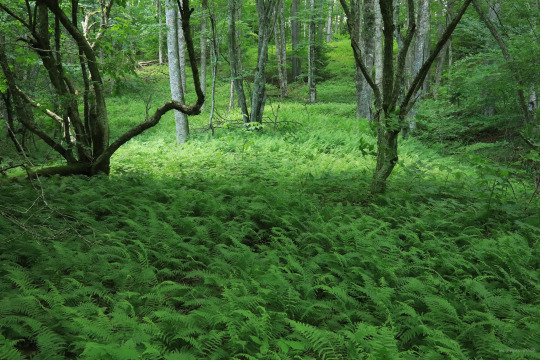





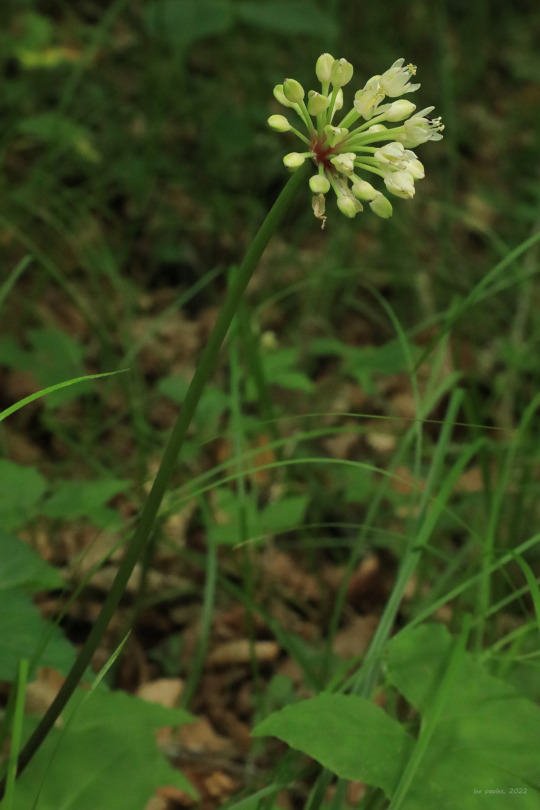

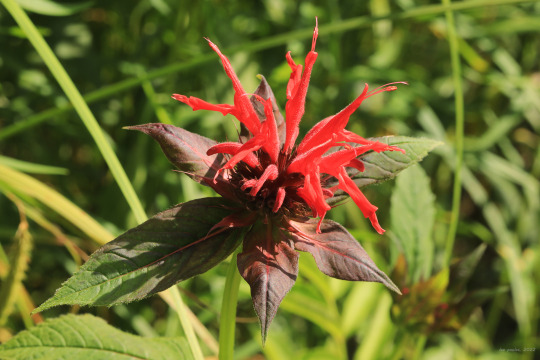
A few mementos from a hike last weekend on Cowpasture Trail at the Cranberry Glades Botanical Area.
From top: rose pogonia (Pogonia ophioglossoides), a delicate and fragrant bog orchid; mountain wood sorrel (Oxalis montana), a shade-tolerant perennial with an affinity for mossy nooks; round-leaved sundew (Drosera rotundifolia), a carnivorous native of the local sphagnum bogs; tall meadow rue (Thalictrum pubescens), which produces loosely-clustered panicles of starry, white flowers; hemlock varnish shelf (Ganoderma tsugae), a beautiful shelf fungus with a lacquer-like surface; a ramp (Allium tricoccum) flower, which emerges from the forest floor in late June/early July after the plant’s leaves have died back; black-eyed Susan (Rudbeckia hirta), also known as gloriosa daisy, one of summer’s finest wildflowers; and scarlet beebalm (Monarda didyma), also known as Oswego tea, a stunning pollinator plant in the mint family much loved by hummingbirds.
#appalachia#vandalia#west virginia#summer#wildflowers#flora#allegheny mountains#monongahela national forest#cranberry glades#cowpasture trail#pogonia ophioglossoides#rose pogonia#snakemouth orchid#oxalis montana#mountain wood sorrel#drosera rotundifolia#round-leaved sundew#thalictrum pubescens#tall meadow rue#ganoderma tsugae#hemlock varnish shelf#allium tricoccum#ramp#rudbeckia hirta#black-eyed susan#monarda didyma#scarlet beebalm#oswego tea
112 notes
·
View notes
Text
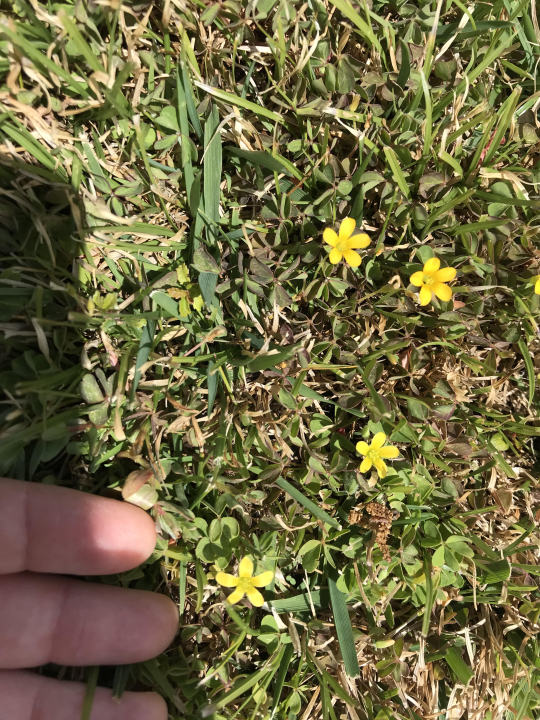
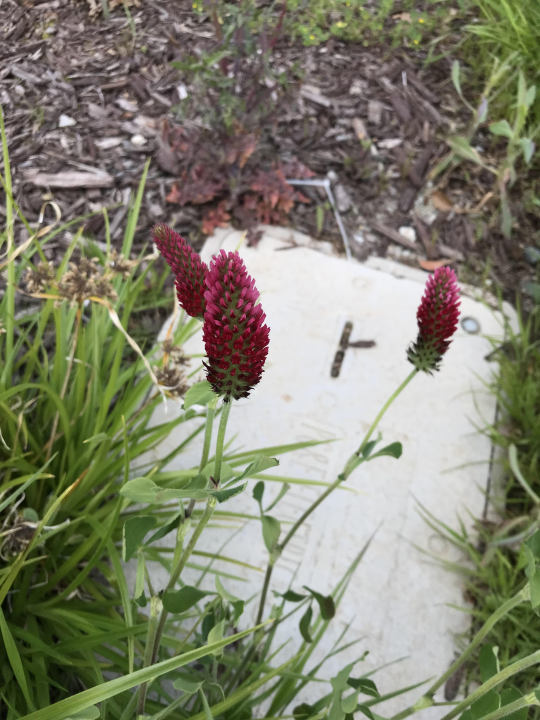

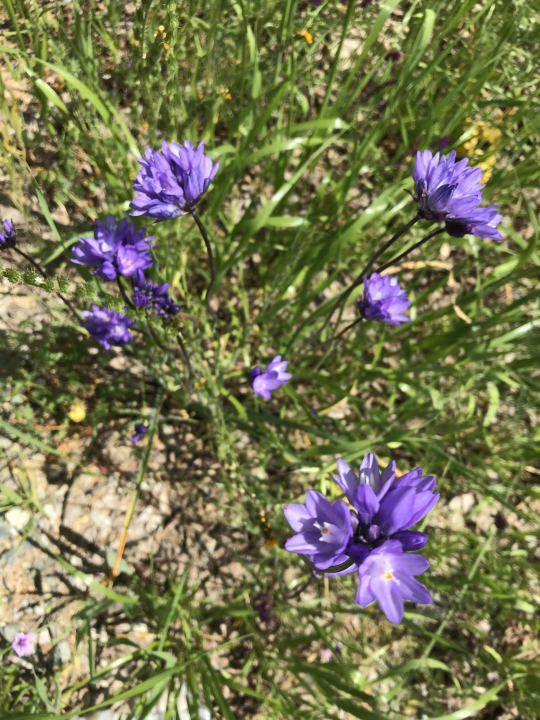
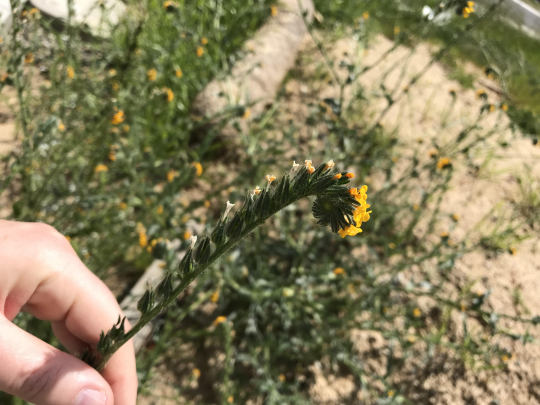
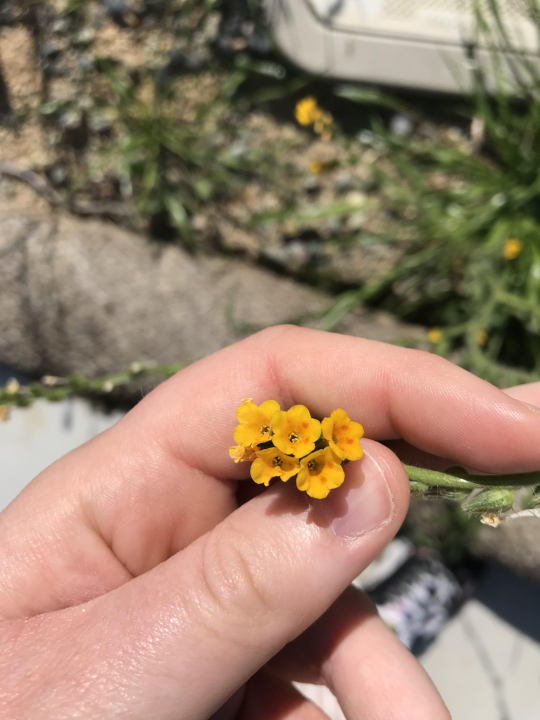

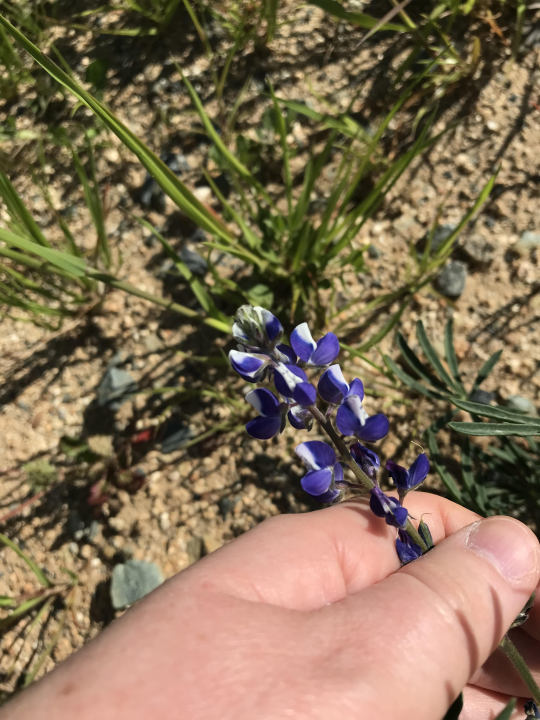
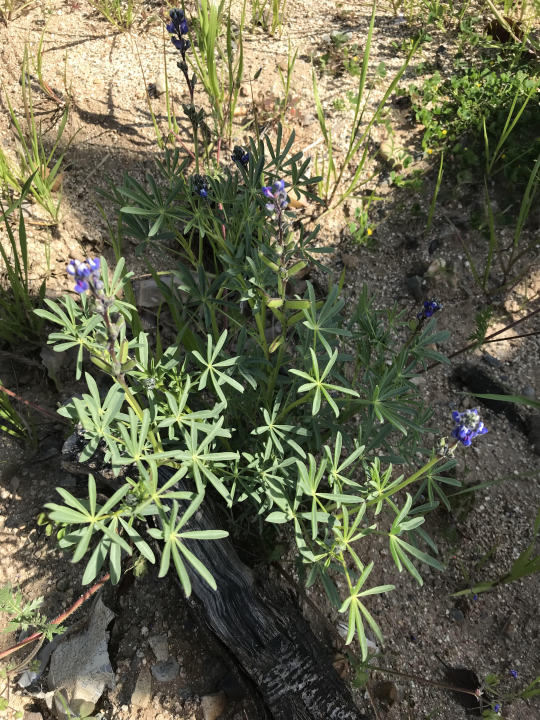
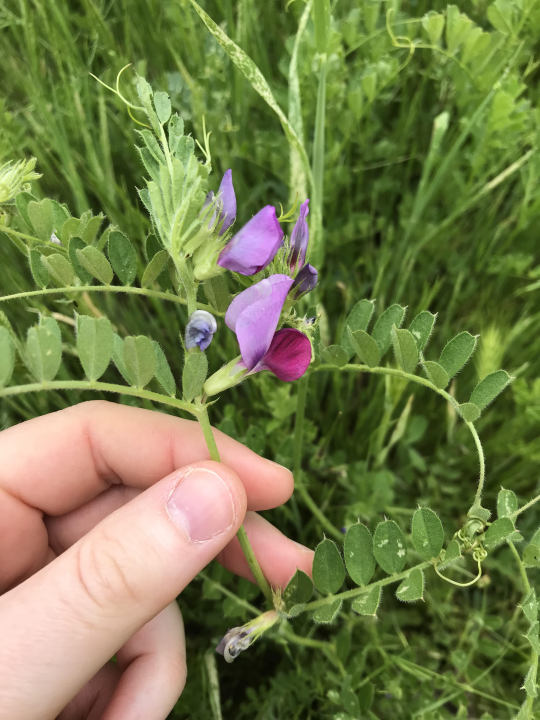

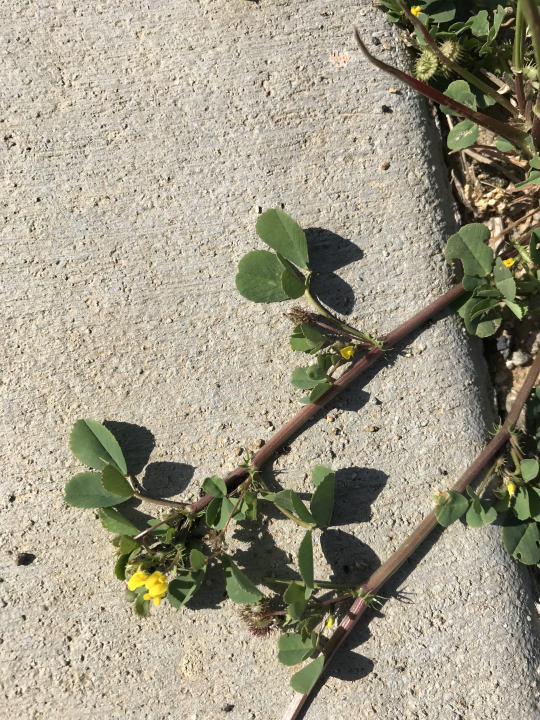
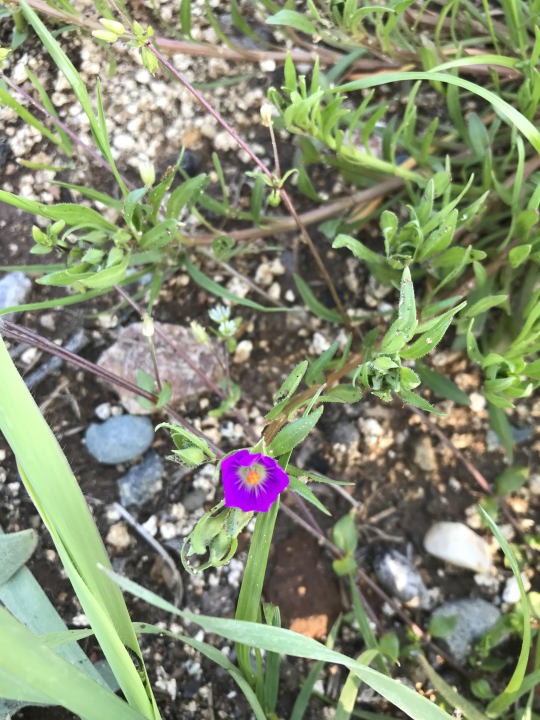
Flowering 'Weeds' in my Neighborhood
Hello and welcome to my informal tour of some of the flowers in my California neighborhood. I just wanted to identify them when I got home so I made this post. We tend to take these plants for granted but I wanted to learn more about them. Forgive the photo quality, my phone is a potato but I am upgrading it soon. (Also I was being kind of lazy with these photos, since it was just for IDing and not for looks)
1.) Yellow Woodsorrel (Oxalis stricta or Oxalis corniculata)
These itty bitty yellow flowers (and clover-like leaves) often found in lawns are apparently woodsorrels, in the genus Oxalis. The flowers are around the same size as Scarlet Pimpernell (Anagallis arvensis), another little flower often found growing in lawns around here. Plants in this genus are edible, apparently, and have a nice sour tanginess to them. All parts are edible and can be eaten raw or cooked, and are nice in salads, I'm told.
It seems the plants in this genus have a wide range of flower sizes, because this genus also includes Oxalis pes-caprae, which has the same clover-like leaves, but it has yellow flowers that are ~1 - 1.5 inches large, which grow on long stalks. This species is known colloquially as Sourgrass where I'm from, and as a kid I often picked the flowers to chew on the sour stems. Plants of this genus are often invasive here, but there are also lots that are native to California.
2.) Crimson Clover (Trifolium incarnatum) - Invasive
Often used for erosion control (even though it out-competes other plants, including natives), for feeding livestock, or as a nitrogen-fixing cover crop. The seeds, sprouts and flowers are edible for humans, too. The red flowers are very beautiful and bees love them.
3.) Long-beaked Storks Bill (Erodium botrys) - Invasive
Another common sight in California yards is the Storks Bill, named after the long, pointy seed pods that look like little spears. My mother passed on the suburban lore to me and my little brother when we were kids, explaining how you can push one of these pointy seed-pods into another one and create a pair of scissors with them. Therefore we referred to these as "scissors plants." However, the plant's seed pods are most interesting when they break open explosively. The seeds that immerge look like sharp little corkscrews that bury themselves in the earth. This plant is reportedly edible, and typically the leaves are eaten when the plant is young. The plant has pretty little pink/purple stripey flowers in the spring.
4.) Blue Dicks (Dipterostemon capitatus) - Native
A beautiful California native wildflower. It has a history of being an important food source for Native Americans. The part eaten was the 'corm,' which is similar to a tuber and also starchy. There is a similar-looking native flower called Forktooth Ookow (Dichelostemma congestum) but this site shares how to tell them apart.
5 - 6.) Common Fiddlenecks (Amsinckia menziesii) - Native
These pretty yellow flowers grow in clusters that gradually unfurl like the neck of a fiddle. Goldfinches love the seeds and it's an important host plant for some insects; its flowers are also valued by pollinators.
They are unpalatable plants to livestock (they have itchy hairs), which is good because they are toxic to livestock if eaten in large amounts. (This typically will not happen unless their feed becomes contaminated with it, since as I mentioned, they dislike eating the plants!) It's probably best that humans don't try to eat this plant, as a result. It's also best to not grab these plants like I did in the photo, haha, because the hairs can irritate skin. (Didn't bother me, but ymmv)
7.) Wild Radish (Raphanus raphanistrum) - Invasive
This plant is in the mustard family (Brassicacea). As you may know, the mustard family is very important to humans, and includes a bunch of cultivated crops (cabbage, broccoli, kale, turnips, radishes, etc). As such, all parts of this plant are very edible, and it has a reportedly peppery taste. It's invasive here in California so you don't need to feel bad about harvesting it. They also hybridize readily with cultivated radish. It's a very hardy plant that has spread all over. You see these guys everywhere, in ditches on the side of the road, etc.
8 - 9.) Lupines/Blue Bonnets [possibly Coulter's lupine (Lupinus sparsiflorus)?]
This genus, the Lupins, is a very large genus and many of the varieties have been cultivated by humans for both food and for looks. However, some varieites are native to California, such as Coulter's lupine. They are very pretty flowers that look similar to pea plants, because it is in the same family (Fabaceae). Lupin beans are edible but need to be processed correctly first, or else they can poison you (the same is true of many popular legumes). The ones that have been bred for eating require less processing.
10.) Common Vetch (Vicia sativa) - Naturalized
Another wildflower in the same Fabaceae family, Vetch also has gorgeous little purple flowers and produces little pea pods too. It's valued as livestock fodder and as green manure/rotation crop, and like the Lupins, its seeds need to be processed properly before humans eat it. The plant is very 'grabby' and will use plants nearby to help prop it up as it grows. So, if you have something else in your garden, you might need to pull out vetch if it's grabbing your plants.
11.) Miner’s Lettuce/Spring Beauties/Winter Purslane (Claytonia perfoliata) - Native
This native plant has big, cronchy leaves that I'm told taste excellent in salads. They tend to grow after a good rain, during winter or early spring, in damp, shady areas. The plant had been used as food by Native Americans for a long time, and when white people arrived in droves in California for the gold rush, they ate it too; thus the name 'Miner's Lettuce.' Their leaves kind of look almost like lily pads, and little white flowers grow in the center. They're quite recognizable once you notice them, and they're very nutritious, apparently.
12.) Burr Clover/Burr Medic (Medicago polymorpha) - Naturalized
Considered useful for livestock fodder, erosion control and soil improvement. It has little yellow flowers and its seed pod is a pokey little burr. It grows very low on the ground, often found in lawns. It's edible, especially the young leaves. The seeds are apparently edible too but there's only one seed per burr and it's rather demanding to gather and process, as you might imagine.
13.) Red Maids (Calandrinia menziesii) - Native
I found this lone little flower among all the other wildflowers around here after the rains. Apparently it's a Red Maid, which used to be considered a type of purselane, but has recently switched families, according to Wiki at least. The greens can be cooked and the seeds toasted.
2 notes
·
View notes
Photo
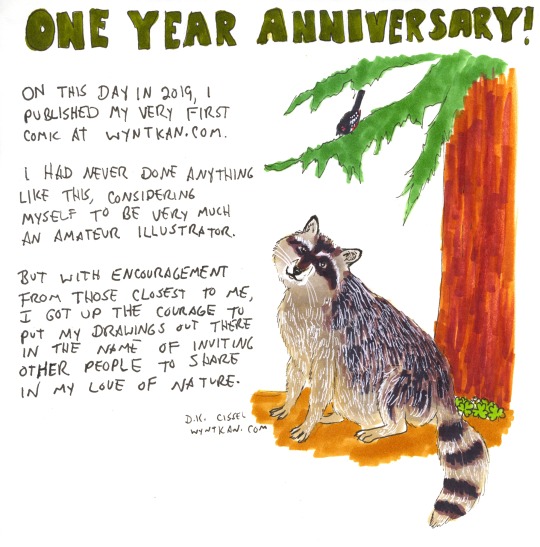


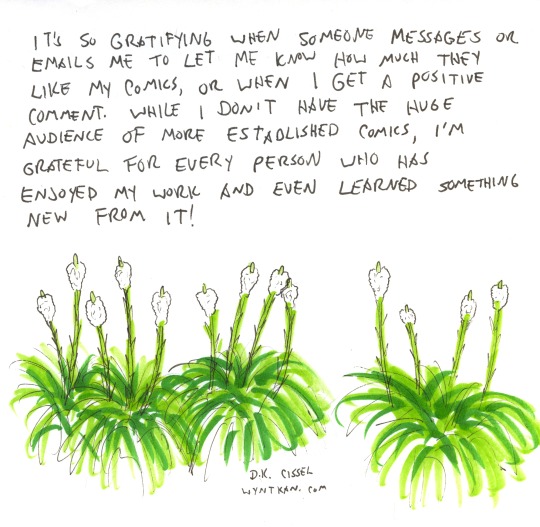

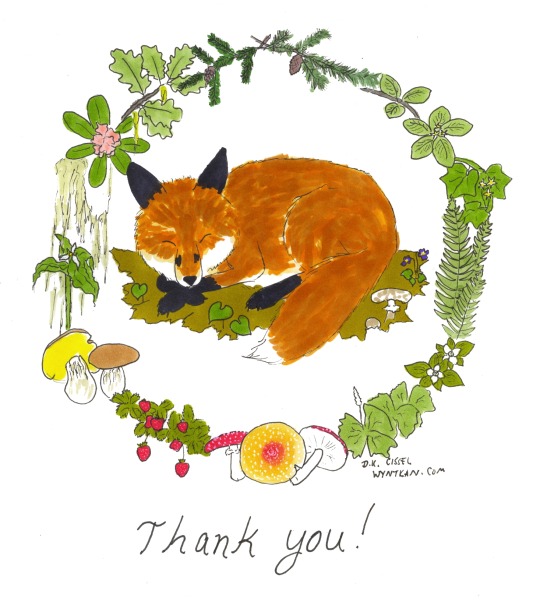
And here we are, a year later! I'm so used to letting projects like this fall to the wayside, and when I started I honestly worried whether I'd be able to keep up the pace. And yet here I am, still posting comics at a rate of one one week, two the next, wash, rinse repeat (plus those extra Mt. St. Helens comics I did last spring!) I'll admit that people's enthusiasm for my work is a big part of what helped keep me going even when I was tired, or discouraged, or really stinkin' busy, because I wanted to keep sharing what I was creating with you all. But I also found that this continued to be fun instead of work, which is the whole point: something in my life that wasn't just a way to make income.
Which isn't to say there aren't ways to help me pay for art materials, of course. My Redbubble shop, for example, actually has a few more designs than what I said in the comic since there were a few drawings that I liked enough to add as stickers and other fun stuff (that last page design is available as a greeting card, with and without text!) But this is still by and large a sideline, a nice break from my day job and a creative outlet that doesn't need to be measured in sales.
If you want to do something nice for my anniversary, please share my work with others! (Or reblog, or retweet, whatever's appropriate.) You can find my social media links at the bottom of any page at http://wyntkan.com. I also always appreciate likes and comments, and I'm open to suggestions for topics for future comics, too.
Finally, again, THANK YOU! It's been nice to have people to share this piece of my creative life with, and I look forward to giving you more fun nature comics to enjoy.
Species portrayed: raccoon (Procyon lotor), western red cedar (Thuja plicata), spotted towhee (Pipilo maculatus), redwood sorrel (Oxalis oregana), American crow (Corvus brachyrhyncos), beargrass (Xerophyllum tenax), Pacific golden chanterelle (Cantharellus formosus), red fox (Vulpes vulpes), lodgepole pine (Pinus contorta), Douglas fir (Pseudotsuga menziesii), Garry oak (Quercus garryana), Pacific rhododendron (Rhododendron macrophyllum), cascara (Frangula purshiana), coastal manroot (Marah oregonus), sword fern (Polystichum munitum), old man's beard (Usnea longissima) king bolete (Boletus edulis), beach strawberry (Fragaria chiloensis), fly agaric (Amanita muscaria, Amanita Muscaria var. guessowi), vanilla leaf (Achlys triphylla), western bunchberry (Cornus × unalaschkensis), western lily of the valley (Maianthemum dilatatum), Western matsutake (Tricholoma murrillianum), early blue violet (Viola adunca)
Website | Redbubble | Ko-Fi
Transcript under cut.
[Title: One year Anniversary!]
[First image: a brown raccoon sits under a western red cedar tree next to some redwood sorrel; a spotted towhee perches in the branch overhead.]
On this day in 2019, I published my very first comic at WYNTKAN.com. I had never done anything like this, considering myself to be very much an amateur illustrator. But with encouragement from those closest to me, I got up the courage to put my drawings out there in the name of inviting other people to share in my love of nature.
[Second image: Instead of asterisks the artist used a pink flower, a canine pawprint, a blue feather, a brown mushroom, and a sand dollar.]
So where has it gotten me? Well, a year ago I started with all zeroes, and now I have:
* 81 comics, 25 multi-page and 56 single page
* 76 followers on Facebook, 337 on Twitter, 667 on Tumblr, and 109 on Instagram, along with 1702 hits on my website, 138 subscribers on Webtoon and 9 on Tapas
* Featured 354 unique species in my comics, including a wide array of animals, plants & fungi
* Set up a Redbubble shop with 18 designs, and a Ko-Fi tip jar
* Slightly more legible handwriting, and a lot more drawing experience
[Third image: a black crow looks at the viewer while standing on the ground]
Now what? Well, obviously I want to keep making comics, as well as taking the occasional commission. If I can dig up more time (that mythical beast!) I’d love to do more non-comic art, including more stickers!
[Fourth image: a field of beargrass is in full bloom with big white flower clusters]
It’s so gratifying when someone messages or emails me to let me know how much they like my comics, or when I get a positive comment. While I don’t have the huge audience of more established comics, I’m grateful for every person who has enjoyed my work and even learned something new from it!
[Fifth image: Golden chanterelle mushrooms pop out of a mossy forest floor]
And when the voice of doubt in my head says my art sucks and nobody cares, I will remember that I am further along and more experienced than if I had never started. I’ll tell that voice to go take a hike (it’s good for you!) And then start the next comic.
[Sixth image: A red fox sleeps in a bed of moss, surrounded by many species of Pacific Northwest native plants and fungi in a ring around it.]
Thank you!
44 notes
·
View notes
Text
What are the most suitable blooming house plants experts choose?

Top 10 indoor flower plants
African violet
African violets are among the easiest to grow flowering houseplants. They bloom year-round with little effort. Choose from hundreds of varieties and forms, some with variegated foliage or ruffled or white-edged blooms. African violet likes warm conditions and filtered sunlight. Avoid getting water on the fuzzy leaves; cold water causes unsightly brown spots. African violet is one of the most preferred plant by interior plant design experts.
Peace Lily
The peace lily is an easy-care plant that tolerates low light and low humidity. Flowers consist of a showy spoon-shaped white spathe and spike of creamy white flowers. Bloom is heaviest in summer, but many varieties bloom throughout the year. The glossy, lance-shaped leaves are attractive even when the plant has no blooms.
Hibiscus
Tropical hibiscus is the ultimate plant for creating a touch of the tropics. It forms huge blooms, up to 8 inches in diameter, on a shrubby upright plant that you can train to grow as a tree. Individual blossoms last only a day or two, but plants bloom freely from late spring through fall and occasionally through winter. Keep the soil uniformly moist and give the plant as much indoor light as possible to keep it blooming.
Oxalis
Oxalis bears triangular, clover-like purple leaves and an almost constant show of pink or white blooms. Look for varieties that have plain green foliage with or without silvery accents. Oxalis grows from small bulbils in the soil; you can divide these any time the plant becomes crowded in its pot.
Anthurium
Anthuriums bloom in festive shades of pink, red, lavender, or white, and last for two months or more. They also make a long-lasting cut flower if you can bear to cut them. Anthurium needs a medium to bright light to bloom well but can be grown as a foliage plant with less light.

Jasmine
There are many types of jasmine. Many-flowered jasmine, polyanthus, and Arabian jasmine are two of the easiest to grow; just give them plenty of light and moisture. They'll all bear fragrant pink to white blooms on vining plants.
Flowering Maple
Crepe-paper-like blooms in shades of red, pink, orange, or yellow dangle among leaves like festive lanterns. Many varieties have splotched or variegated foliage for extra interest. Grow the plant upright as a tree, prune it back to keep it shrubby, or even grow it in a hanging basket. Its common name comes from the leaves, which resemble those of a maple tree.
Kaffir Lily
Kaffir lily is also commonly called clivia. As a houseplant, it usually blooms in winter with clusters of up to 20 reddish-orange or yellow tubular flowers. Clivia blooms only when it has been exposed to cool, dry conditions, so give it lower temperatures in winter and keep it on the dry side. With its deep green strap-like leaves aligned in a single plane, the plant is attractive even when not in bloom.
Streptocarpus
Also called Cape primrose, Streptocarpus blooms almost continuously if given the right conditions. Most of the hundreds of hybrid varieties available bear trusses of pink, white, purple, or red flowers, often with contrasting white or yellow throats. Except for providing cooler winter temperatures, treat it as you would its cousin, African violet.
Calamondin Orange
This hybrid between a mandarin orange and kumquat bears fragrant white blossoms in late winter or spring. The wonderfully fragrant flowers develop into showy 1-inch-diameter orange fruits on a shrubby plant with glossy green foliage. Fruits can remain on the plant for many weeks.
Whether it is an office or a home Interior plants and flowers always bring extreme joy and a soothing atmosphere for you. Plant Care Specialists, Fort Lauderdale has 20 years of experience in this field assuring the greatest results of interior plant maintenance service, Fort Lauderdale. We provide the best interior plant maintenance in Hollywood, FL, to make your plants truly flourish and thrive. We expertise in floral designs and blooming and are providing the most reasonable charge and bring quick results. If you wish to add your home and office a new look with nature’s greatest gifts, then contact our team of experts and consume the best interior plant care service Fort Lauderdale.
Contact Details :
Plantcare Specialist
Contact Number: 954-371-2042
Email ID: [email protected]
Address: 2801 NW 6th Avenue Wilton Manors, FL 33311
2 notes
·
View notes
Text
Oxalis tetraphylla 'Iron Cross' (Good Luck Plant)
If you've always believed that flowers are mandatory for a colorful garden, allow Iron Cross oxalis plant.
It produces clusters of rosy pink blossoms in the summer but what really pushes this winner to the front of the pack is its foliage.
Deep purple markings highlight the junction of the four heart-shaped leaves for dramatic additions to urns, windowboxes and sunny windowsills.
Colorful year-round.
It is a bulbous perennial forming a lush mound of rich green leaves composed of 4 heart-shaped leaflets, each with a dark purplish blotch at its base.
The burgundy marking across the center of the leaves is reminiscent of a cross.
They really stand out with its two-toned, heart-shaped leaves that make a dramatic statement wherever they're planted.
Can be Planted Indoors
Bloom Time: Flowers in 10-12 weeks from planting
Rosy pink flowers and foliage with purple cross-shaped markings.
#oxalistriangularis #houseplantclub #plantaddict #indoorplants #plantsmakepeoplehappy #houseplants #plants #plantlover #livingwithplants #ihavethisthingwithplants #timelapse #indoorjungle #foliage #urbanjungle #plantstagram #plantsofinstagram #plantenabler #houseplantsofinstagram #plantcare #plantcetera #plantsarefriends #flauntyourleaves #plantlady #indoorgarden #country_stilllife #plantemonium #containerplants #greenchats #terracegardening #balconygardening

1 note
·
View note
Text
The luck of the Druids
As we head deeper in to the Spring Season I find myself surrounded by a sea of Clovers (Trifolium) when set out on my day to day walks. Of course I am naturally compelled to go looking for four leaved Clovers in the hopes that it might infuse my life with a bit of luck. I am so fortunate to have a huge collection of four and even five leaved Clovers........ But what is it that makes four leaved clovers so special and lucky you may ask?
Before we get started on the lucky side of the Clovers let’s talk about how to identify Clovers, fun fact Clovers are actually apart of the Pea family! How cool is that?! . We quite often confuse three leaved Clovers (or Shamrocks) with Wood Sorrel which is very easily done as they have an increadible resemblance.....Clovers typically will have beautiful different coloured flowers, usually with clustered adpressed petals acompanied by the three leaved shamrocks which will typically have oval leaves with a white crescent shaped mark across the middle, these traits are commonly found in the the White Clover (Trifolium repens) and the Red Clover (Trifolium pratense) the white Clover will usually have a white flower though and the Red Clover will usually have a Pink/Purple flower- these two are the most common Clovers you will see- when it comes to identifying Wood Sorrel (Oxalis acetosella) you will see that the leaves are Trifolate as oppose to Oval and the flowers are ver simmilar to that of Wood Anemone. If you wish to read more on Clover and Sorrel specifications I would recommend a read of ‘The Wild Flower Key’ by Francis Rose and ‘Collins Complete Guide To British Wildlife’ by Paul Sterry.
Let’s get back to what makes four leaved Clovers so lucky. The first known reason for the leaved Clovers powers of luck dates back to the famous St.Patrick on the Emerald Isle of Ireland. Ireland is where the term Shamrock comes from which defines a three leaved Clover- this Clover is hugely symbolic on its own as St.Patrick would use this in his Christian teachings of the Dortrine of Trinity, the three leaves symbolised The Father, The Son and the Holy Spirit ( The Holy Trinity) but there isn’t a lot of mention as to what makes the four leaved Clover so special -other than the fact that the four leaves stand for Faith, Hope, Love and Luck. It is said that Ireland is home to more four leaved Clovers then anywhere else in the world which is where the expression ‘luck of the Irish comes from’.
The Lucky four leaved Clover is a Legendary Plantae that dates back further than St.Patrick. The Druids of Ireland believed that the four leaved Clover, when carried on ones person, would offer magical protection from evil and would ward off bad luck. The three leaved Clover was also believed to hold magical valu to the Druids, they believed that they would allow them to see approaching evil spirits which would allow them to escape in time before being captured by the evil spirits. Children of the Middle Ages believed that the four leaved Clover would give them the power of site to see magical beings such as faries.
There is a 1 in around 10,000 chance of finding a four leaved Clover amongst shamrocks as Clovers do not naturally produce a fourth leaf which is why is it so rare and lucky to find one.
If you do happen across a four leaved Clover stay in the same Clover patch to look for more! There is more chance to be an occurrence of more than one Clover with four leaves in the same patches which is 100% true as whenever I have been so fortunate to find one I will stay in the same patch and find another and another and another then before I known it I have a small bouquet ready to take home!
Happy Four Leaved Clover Hunting!!!!!
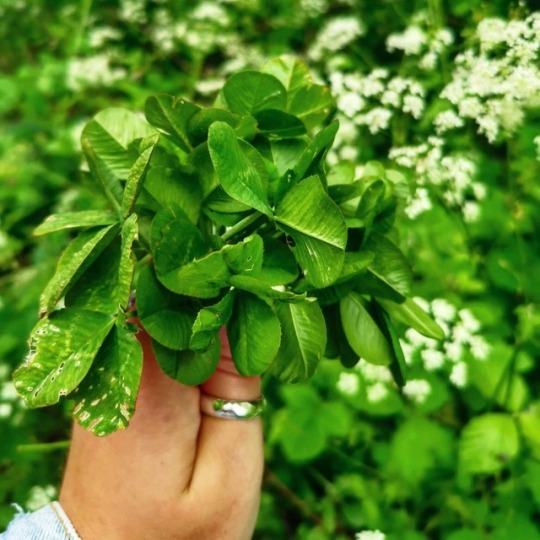
#clovers#shamrocks#ireland#luckoftheirish#luckofthedruids#wish me luck#lucky#fourleavedclovers#fourleaved#emeraldisle
7 notes
·
View notes
Photo



Oxalis Mijke - Shamrock
Oxalis triangularis are highly “photophilic,” which means that they open and close not just their blooms, but also their leaves in response to light. At night, neatly folded, oxalis triangularis looks like a cluster of little purple butterflies that then open wide to the morning light. Both the vivid purple color of its leaves and this constant slow motion seems to enchant all who grow it – even “non-gardeners” fall in love this charming beauty. To capitalize on its unusual coloring, containers in silver or chartreuse are especially effective.
Incredibly long lived, oxalis triangularis often become "heirloom plants" passed down from generation to generation within a family. We often hear customers’ stories of the plants becoming a cherished family tradition. One customer told us she was enjoying the same bulbs as their great, great-grandmother who harvested them as a child 107 years ago! Basic CareOxalis triangularis bulbs look like small, immature pinecones. When planting a container for indoors, go ahead and crowd your bulbs, spacing them just an inch apart for a full look fast. Just poke the bulbs into the soil – any way up is right. Water lightly just once every couple of weeks until new growth appears. In about 6 weeks from planting, your new purple shamrocks will begin to appear, and will fill in to become lush and full soon after. Weekly watering should be light. Too much water will send the plant back into dormancy.Indoors, keep your oxalis triangularis in a sunny spot. You will find the deep purple foliage really brings out the vibrant green of other plants, and the color contrast makes your other houseplants seem to glow with health.Please note that oxalis triangularis occasionally go dormant, looking like the entire plant has died. Because this happens generally during the summer every 2-7 years when the plant is indoors, it seems like a serious problem rather than a periodic event. There is no need to toss your beloved triangularis! Simply stop watering and let the soil thoroughly dry. Set the plant aside where it is no longer center stage, but where you will still see it. In a few weeks, you will see a new leaf emerge. That is the time to resume watering. Soon, your purple shamrocks will be lush and full again. care source
13 notes
·
View notes
Text
7 Small But Important Things To Observe In Summer Floral Arrangement
Whereas other instances of 12 months, like fall, spring and even the winter season, have been gaining increasing recognition as the proper time for internet hosting a wedding, the summer time season always has been, and probably all the time will be, probably the most Flowers For Summer most well-liked time to host the right marriage ceremony. This can be a good choice for a long-flowering plant for a sunny border. Gardenia plants and bushes bloom heartily if taken care of properly. Your florist can inform you whether or not the tightly furled small buds of tea roses, or huge hardy blooms will work best on your marriage ceremony designs. Sendflowers provides clients a enjoyable and beautiful selection of flowers for supply. Whether it is one thing little or one thing grand, share a smile and love this summer with patriotic present ideas.
The surface of a flower that may be seen easily consists of petals, the Sunny Plants colored a part of the flower, and the sepals, the small green buildings that look like little petals at the base of the flower. And in contrast to most crops, these flowers thrive in some shade. Stephanie, beautiful flowers and great pictures. Freesia - freesias are a fragrant, bell-formed flower with yellow, red or pink coloring. White flowers cluster like butterflies atop tall spikes on these ethereal 2½- to four-foot-tall crops. Stunning flowers and great lens on your cottage garden. Put on some sunscreen in your protection, put in your gloves and hats and Summer Floral Arrangement begin pulling out those cussed weeds on our gardens, let's plant some good blossomed flowers and vegetables so as to add some nice colour into our back yard and fresh organics to eat.
This elegant foxglove , redolent with tall, golden spires of tubular flowers, is commonly used as a free-seeding biennial in prairie type gardens. Plant in full solar with good drainage and have a reduce flower backyard before your eyes. Most daisies are Summer Centerpieces For Tables perennials, and the white-coloured shasta daisy is among the most popular in that group. The eight finest spring and summer time flower festivals to see within the u.s. Oxalis is a typical flowering plant rising all around the world. Like clematis , they like cool feet and sizzling heads, so plant them in full sun but use mulch or plant yours with shorter vegetation that can cowl their roots and keep them cool.
I believe my beloved son might be quite happy with this reward basket to have fun his forty seventh birthday. These delicate border plants (tiny flowers with rounded petals) spread out all through the growing season, with the seeds dispersing by the wind. Pay special consideration to leaves under the water line as a result of they're Summer Table Centrepieces going to decompose, inflicting rot and micro organism to grow, which is able to shorten the lifespan of your blooms. Vegetation have different preferences for soil. Roses are particular plants to specific emotions. Hello mardi, some of my favourite flowers here, i really like the verbena and coneflower especially. There isn't any better place to order spring flowers to mesa, arizona than arizona florist. You will have a ravishing combine of varieties and colors.
Dahlia is an exquisite summer flower and its bright flowers can cheer up your summer season canvas. Rudbeckia hirta, generally referred to as black-eyed susan, is a north american flowering plant within the sunflower family, native to jap and central north america and naturalized in the western part of the continent in Summer Flower Centerpieces addition to in china. These crops grow as tall as five feet and are hardiest in zones four - 8. The blooms on these fall flowers are orange, pink, or yellow in color, and bloom in the late fall months.
TAGS: Summer Centerpieces,Summer Flower Arrangement,Flower Arrangements For Summer
1 note
·
View note
Photo

On an #Indian #summer day (the warmest October day in 7 years) I'm hidding in the shade whilst my papa is #gardening. That's the #Oxalis weed in the background 😹😹😹. . #Oxalis has small, pale green clover-like leaves made up of three heart-shaped leaflets. Flowers vary in colour from white, yellow and pink to red. Clusters of leaves grow from finger length to hand length in height and form mounded rosettes. . There are a wide variety of Oxalis species and many of them can be problem plants in our gardens. Low growing Oxalis is more of a nuisance than anything else. If allowed to get out of control, it can form a dense carpet of foliage that suppresses the growth of other plants. This would make it a particular problem in a permanent planting like an asparagus patch. Oxalis doesn’t attack and trample neighbouring plants but it does compete for essential nutrients and it is very persistent and invasive thanks to a few clever tricks. . Oxalis spreads by seed as well as small bulbils that develop from the roots. When you come across the clover-like foliage in your garden and yank it out of the ground by hand this releases a parent bulb and numerous smaller bulbils in the soil below. All of these will simply grow on unhindered. If you are digging through a bed and you dig up Oxalis plants to remove foliage then the small parent bulb and even smaller bulbils will be even happier as they are hard to see and most often get freely distributed through your soil to grow into even more plants. . #catwoman #catch #catering #catlove #ilovemycat #cats #cats_of_instagram #catnap #catstagram #catnip #catlovers #catoftheday #cute #gardenparty #gardenlove #gardendecor #gardena #gardensbythebay #gardencenter #gardeningtips #gardenia #garden_styles #garden_explorers_ #gardening_feature #garden_explorers #mygarden https://www.instagram.com/p/BowbwAlFIwe/?utm_source=ig_tumblr_share&igshid=n6jpmxyp7ujz
#indian#summer#gardening#oxalis#catwoman#catch#catering#catlove#ilovemycat#cats#cats_of_instagram#catnap#catstagram#catnip#catlovers#catoftheday#cute#gardenparty#gardenlove#gardendecor#gardena#gardensbythebay#gardencenter#gardeningtips#gardenia#garden_styles#garden_explorers_#gardening_feature#garden_explorers#mygarden
2 notes
·
View notes
Text
This winter we have only had one time the temperature dropped below freezing. The plants browned a bit but for the most part stayed green. We have set up a green house on the porch for our potted plants. The plants in the ground have to deal with the weather, come what may! This is a shot of our south bed. We call it our warm bed because most of the plants here flower in shades of yellow. The leaves of the Lime Sizzler™ Firebush, Hamelia patens ‘Grelmsiz’ PP26247 are yellow gold and stand out when they catch the light.

And even the Saratoga Gold Yaupon holly has yellow berries.

What has caught my eye this morning is the Copper Canyon daisies.

That have gone crazy and even grown through the fence. The pretty glass flower is a gift from our friend Linda. It fits perfectly into this bed.

Copper Canyon daisy, Tagetes lemmonii
I found this description on the Central Texas Gardener website. “Copper Canyon daisy is native to the Sonoran desert of Southern Arizona and Northern Mexico. This perennial shrub is very drought-tolerant and suffers if soil is kept too wet, so good drainage is important. On heavier soils, consider planting in berms amended with decomposed granite.
Plant in full sun to part shade. Include in low-water succulent designs to complement structural plants.
Copper Canyon daisy gets about 3-6’ feet in height and can spread just as far.
Its narrow, pungent leaves deter deer (usually!).
Blooming mainly in late summer through fall, it can also flower in late spring. Its small, golden yellow flowers attract bees and butterflies.
In most winters, top growth will die back after the first frost. Shear back to the ground in late winter/early spring. If it blooms in spring, trim it lightly in early summer to reinvigorate the plant and encourage summer foliage and fall blooms.”

We have never had them grow so big. They froze to the ground last winter. It is such a treat to be greeted with the sunny daisy like flowers. As I continued on to the west bed, a hodgepodge of perennials and annuals, I found two Monarch caterpillars. I think it is a bit late for them. We really need to cut back the Tropical milkweed but it keeps blooming and there have been a steady stream of pollinators coming through the garden this winter. We are careful to source our Asclepias curassavica from sources that don’t spray it with harmful chemicals. This milkweed is from the genus, Asclepias. It is native to the American tropics.
Continuing on north I noticed that the Purple Tubeflower Iochroma has a few clusters of flowers. Rare to see it so well into winter. On closer inspection I noticed the bee. Pretty good shot for a mobile phone (Samsung 7 Edge)

The bees are happy!

And right next door is Ember’s Wish™ Salvia. This sage has been blooming since last spring. It is a bright beacon for the bees and is often covered in them.

It is a real treat to have so much color in the middle of winters. Last year we were looking out at brown. We have a few small deciduous trees which really show off their structure in winter. He is our Ginkgo Biloba ‘Weeping Wonder” under-planted with Texas Bluebonnets.

Finishing my trip with the north bed. Where only the Euphorbia, Diamond Frost® and Oxalis Triangularis, Purple Shamrock are blooming. This bed has mostly purple flowers. will be lovely in spring. The plant that looks like clumps of grass is Hypoxis hirsute, commonly called Goldstar, hairy Star grass, Yellow Star grass. It will have yellow flowers. Will post when it is in bloom.

Happy Gardening from Laurin and Shawn at Ravenscourt Gardens.
January in our garden ~ flowers in winter! This winter we have only had one time the temperature dropped below freezing. The plants browned a bit but for the most part stayed green.
#Copper Canyon Daisy#Ember’s Wish™ Salvia#Ginkgo Biloba &039;Weeping Wonder#Houston Heights Texas#Iochroma#Lime Sizzler Firebush#Purple Shamrook Oxalis#Saratoga Gold Yaupon Holly#Tagetes lemmonii#Weeping Ginkgo
0 notes
Text
Other: Request.ForSamples.Oxalis_acetosella
Hello, We need samples of the rhizomatous flowering flower plant Oxalis acetosella. This species, commun in most of Europe and parts of Asia, can be found in moist woods, moorland and shady habitat. Regarding the sampling protocol, this is simple. We only need one individual sampled per population. A population is here defined as any isolated individual or cluster of individuals which are distant of ≥10m from the next isolated or cluster of individuals. To sample a population, just collect the 3 to 9 youngest leaves of a single rosette (individual) of Oxalis acetosella within the population. Collect only safe leaves (no hole or sign of herbivory, no chlorosis or virus attack). Put the fresh leaves in an envelope (standar small paper envelope) with GPS coordinates of that population written on the envelope or at least the name of the locality but lat/long coordinates is the best. So, one enveloppe per population. If you could then collect several populations (15 would be ideal, so 15 envelopes total) from the same forest patch but which are not too close from each others (cf. populations >10m away), this would be optimal. The idea is to collect several (when available) populations from a given forest patch so that the sample is representative of the sampled forest patch. When you are done, put all collected populations from the sampled forest patch (cf. all envelopes with coordinates written on it) in another bigger envelope and send it to this address: Prof. Annie Guiller Edysan FRE 3498 CNRS - UPJV Laboratoire BIPE, Bâtiment des Minimes 33 Rue Saint-Leu, 80000 Amiens FRANCE Thank you for your help. Annie via Gmail
0 notes
Text
My Oxalis Plum Crazy is going through a phase and has grown a cluster of completely black leaves 🖤 via: https://t.co/9epUziljfy
My Oxalis Plum Crazy is going through a phase and has grown a cluster of completely black leaves 🖤 via: https://t.co/9epUziljfy
— Kent Tsom (@kent_ts) July 12, 2019
from Twitter https://twitter.com/kent_ts July 12, 2019 at 04:02PM via Kent Tsom
0 notes